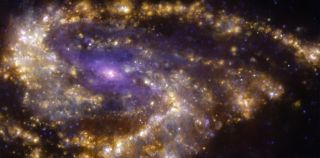This spiral galaxy looks positively royal in vibrant new image
ESO released this uniquely colorized image of the NGC 3627 galaxy

The distinctive spiral of the Messier 66 (M66) galaxy radiates golden and purple gas in this striking new image, released by the European Southern Observatory (ESO).
ESO's Multi-Unit Spectroscopic Explorer (MUSE) used a range of light wavelengths to distinguish between chemical elements in the galaxy and capture the vibrant result. The multiple observations revealed a selection of gasses — oxygen, hydrogen and sulfur — ionized by young stars. The image was released by ESO on May 2.
The image uses a unique cosmic color palette: blue represents the ionized oxygen, red the hydrogen and orange the sulfur. Because stars are born in clouds of gas, a useful way to analyze star formation is to observe the behavior of gas in the galaxy.
Related: The best Hubble Space Telescope images of all time!
During the birth of massive stars, the extreme heat ionizes surrounding gas molecules, which gain or lose electrons. The vivid colors lighting up this image show where these cosmic newborns are likely to be found.
The M66 galaxy, also known as NGC 3627, is more commonly pictured to highlight its star arrangement. Located 31 million light-years away from Earth, M66 is part of the Leo constellation. According to ESA, the galaxy has a diameter of 100,000 light-years.
The asymmetrical spiral arms of the M66 galaxy remain prominent, despite the image's focus on mapping ionized gas. Astronomers believe that the galaxy's off-center core, represented by the image's deep purple hues, and non-uniform structure is a result of interaction with nearby galaxies.
Get the Space.com Newsletter
Breaking space news, the latest updates on rocket launches, skywatching events and more!
The observations that produced this image were made as part of the Physics at High Angular resolution in Nearby Galaxies (PHANGS) project. This project observed the galaxy with telescopes that operated across all wavelengths, with the aim of the studies being to explore which factors most influence star formation.
This particular image is made with data from ESO's Very Large Telescope (VLT) in Chile.
Follow us on Twitter @Spacedotcom and on Facebook.
Join our Space Forums to keep talking space on the latest missions, night sky and more! And if you have a news tip, correction or comment, let us know at: community@space.com.
Ailsa is a staff writer for How It Works magazine, where she writes science, technology, space, history and environment features. Based in the U.K., she graduated from the University of Stirling with a BA (Hons) journalism degree. Previously, Ailsa has written for Cardiff Times magazine, Psychology Now and numerous science bookazines.

